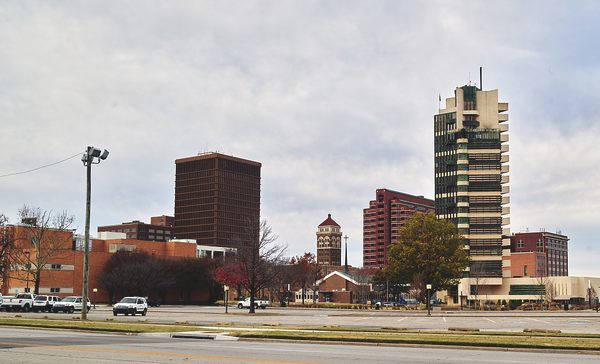Baudelaire Ceus: John Waters is a trained architect. He loves buildings and thinking about them and how they serve society. And he got the bug early.
John Waters: My dad got a book called Architecture in Michigan when I was five years old. And I became obsessed with this book. I blame it on my becoming an architect.
Baudelaire: The book featured a highlight reel of architecture throughout the United States, buildings designed by some of the greatest architects in American history. Folks like Louis Sullivan, Frederick Law Olmsted, and especially Frank Lloyd Wright. John’s fascination for the work on Wright in particular grew so much that years later, when he was on a cross-country trip, he made it a point to make a pit stop to see one of Wright’s most unique buildings.
John: In 1994, I was moving from Los Angeles to Chicago and all my worldly possessions in a U-Haul van. And one of the things I needed to do as I crossed the country was stop in Bartlesville and see Price Tower.
Baudelaire: Bartlesville is a city of 40,000 in Oklahoma. And to be honest, his friend, who didn’t really care about architecture, wasn’t really too thrilled. But John was insistent. They needed to see the tower.
John: This was, you know, pre-Google Maps, pre-anything. We’re driving to Bartlesville and I was just like, look for a building that looks like it’s out of The Jetsons.
Baudelaire: The Price Tower is a 19-story building with floors that extend outward from a central core. The exterior is covered in copper and gold tinted glass, giving it that futuristic look. It wasn’t hard to spot the building once the friends got into town. Aside from its exterior being unique, it dwarfed all the other buildings around it. John was in awe.
John: We were standing out front taking pictures and a woman pulls up, and she’s lovely. And she talks about growing up in Bartlesville, taking your kids to the tower, taking people through. So there’s a real local pride about the building. We talked for 15, 20 minutes. So that was my first experience with Price Tower.
Baudelaire: But that wouldn’t be his last experience. Thirty years later, the fate of Price Tower would be up in the air, and John would be right in the middle of the effort to preserve it. My name is Baudelaire and this is Atlas Obscura, a celebration of the world’s strange, incredible, and wondrous places. Today, we go to Bartlesville, Oklahoma to see Frank Lloyd Wright’s only skyscraper: the Price Tower. We hear why this Oklahoma landmark is so unique and why this iconic building is sitting empty today.
This is an edited transcript of the Atlas Obscura Podcast: a celebration of the world’s strange, incredible, and wondrous places. Find the show on Apple Podcasts, Spotify, and all major podcast apps.
Baudelaire: If you know the name of any one architect, chances are it’s Frank Lloyd Wright.
John: I think you could say he was the first American star-chitect. He really was someone who was a larger-than-life personality.
Baudelaire: Frank Lloyd Wright had a complicated personal life. Multiple marriages, multiple affairs. He got caught up in some scandals. But through all of that, he created some masterpieces. For the most part, he designed single-family homes. His most well-known is probably Falling Water, a three-floor, four-bedroom house built in the midst of thick woods in western Pennsylvania. Let me also add that it’s literally sitting on top of a waterfall. Wright also designed buildings like the Guggenheim in New York. It’s this white concrete structure with a top-heavy spiraling form. That’s seen by many as Wright’s masterpiece, but it’s not alone in its unique design.
John: Whether you like them or not, they’re endlessly fascinating. They are complex. Much as he promoted the idea of simplicity, his definition of simplicity was complex. And they span 70-plus years of work.
Baudelaire: From the 1880s to the late 1950s, Frank Lloyd Wright designed 1,114 architectural works, of which 532 were built. Now, of that 532, Frank Lloyd Wright only has one skyscraper. This skyscraper was originally supposed to go in Manhattan, a place that would make a lot of sense for a skyscraper. But this was the late 1920s, and the whole thing fell through during the early years of the Great Depression.
John: And as architects do, if a project doesn’t go, it doesn’t mean they don’t keep trying to shop it around.
Baudelaire: Wright had the idea on ice for about 20 years until a new opportunity for his design came through. The H.C. Price Company was a business that made pipeline equipment for oil companies, and they wanted to build a new headquarters in Bartlesville, Oklahoma, something that would stand out. Joe Price, the owner’s son, happened to also be studying architecture, and he talked the idea over with one of his professors, and that professor suggested they reach out to Frank Lloyd Wright. Now, let’s pause here for a second just so I can emphasize that at this point, Frank Lloyd Wright was THE star-chitect. He had over 400 buildings designed across four continents. He was the Michael Jordan of architecture. Joe Price’s dad, the CEO of the company, pulled up to Wright at his Wisconsin studio in 1952 and asked Wright if he had any ideas. And Wright pulled out that one idea from a couple decades back. The company called the tower Price Tower, but Wright called it The Tree That Escaped the Forest.
John: He loved to, you know, be quasi-poetics like that.
Baudelaire: The Price Tower looks sort of like a game of Jenga after a few rounds. The central trunk—to keep it with the tree analogy—is actually four elevator shafts that anchor the building’s concrete floors that extend out like branches. It has an oxidated copper color that looks like leaves, and it has gold-tinted windows. It’s an example of something Wright would call organic architecture.
John: One of the things about organic architecture is it’s very much built like this, and I’m putting my fingers together, and you know, I’m like, everything is—everything’s tied together. I have a professor who would say about Wright’s building, “nothing does everything, but everything does something.” There isn’t just like, this is the structure, this is the enclosure, this is this component, this is that component. They’re all working together.
Baudelaire: Price Tower was open to the public as an event space, people could tour the tower itself, there was a restaurant, apartments, a hotel, all this aside from the office spaces on the highest floors. The Price Company enjoyed their masterpiece of a headquarters for 25 years until they relocated to Dallas in 2001. And then, a new, more tumultuous history for the tower began.
John: Price Tower is very different. You cannot do whatever you want to in Price Tower.
Baudelaire: Meaning, it’s not like a standard office building where you can really adjust the space to exactly match your needs. You can’t just knock down a wall, because, well, that wall is actually helping hold the structure together. Wright designed the tower and everything in it, from the couches to the lamps, to sort of remain as is. Everything about its design has a purpose.
John: So, for instance, these two-story apartments in Price Tower are the stairways, the balcony, they’re all part of the structure of the building, as opposed to a typical high-rise where, as I say, you have a different system. It’s a challenging building to steward.
Baudelaire: And that challenge is why the building, this iconic skyscraper designed by one of the most famous architects of all time, is sitting empty today. Price Tower has had three owners since 2001, all eventually facing the issue that the building is hard to turn a profit on while maintaining it exactly as it is. Not only can you not adjust the physical structure, but even the furniture in it must stay. The tower has been closed for seven months and remains in limbo due to a year-long legal dispute over its ownership and future purpose. Adding to the situation, the Price Tower holds significant sentimental value for Bartlesville residents, like the woman John met when he first came in 1994. Many locals hope the tower will reopen and be actively used soon. The Price Tower is a symbol of Bartlesville. It’s on murals and postcards of the city. And this is where John comes in, because he belongs to another group with a stake in the future of the tower. He works for the Frank Lloyd Wright Building Conservancy. Basically, they’re a group that makes sure Frank Lloyd Wright’s buildings across the U.S. are preserved and protected. As it relates to the Price Tower, they’re going to work with whoever the next owner is to make sure the tower can be opened while maintaining it as the piece of art that it is. Just recently, John and some of his colleagues made it out to Bartlesville to do a walkthrough of the tower to see how it’s holding up after being closed for months.
John: There are no utilities currently on. It’s been a real concern. I will say, we have been very concerned about the building over the course of the winter when we went down. I will say, though, we were all prepared for much worse conditions than we found.
Baudelaire: Aside from the basement, which had a couple inches of water, the inside of the tower was in pretty decent shape. It’s still unsettled what will happen next to the tower, though. And John says, though it’s been challenging for its owners over the years, he feels it’s a building worth keeping and maintaining as it is.
John: I think there is a way, I mean, and people write, I mean, we are shaped by our architecture, and that can occur in various ways. And, you know, this is a very special building. I mean, we are very mired in the challenges of it right now. But it is completely one of a kind. This building is amazing. It’s a challenge, but it’s a challenge worth meeting.
Baudelaire: The Price Tower is closed, so if you go to Bartlesville, you can’t actually go in it. But you can take pictures outside of it and enjoy it like John did back in the day.
Listen and subscribe on Apple Podcasts, Spotify, and all major podcast apps.
Our show is a co-production of Atlas Obscura and Stitcher Studios. The people who make our show include Dylan Thuras, Doug Baldinger, Chris Naka, Kameel Stanley, Johanna Mayer, Manolo Morales, Amanda McGowan, Alexa Lim, Casey Holford, and last but not least, Luz Fleming. Our theme music is by Sam Tindall.


